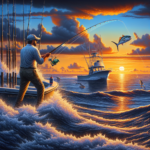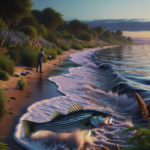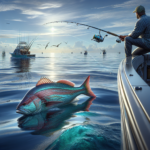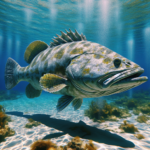Casting for Amberjack in Florida’s Atlantic Coast

Introduction
Did you know that the Atlantic Coast of Florida is one of the premier destinations for catching Amberjack, a fish known for its strength and fighting spirit? Whether you’re a seasoned angler or a novice looking to experience the thrill of reeling in a big one, this guide will provide you with everything you need to know about casting for Amberjack in Florida’s Atlantic waters.
In this article, we will cover the historical and cultural significance of Amberjack fishing in Florida, the best techniques and gear to use, detailed species information, top fishing spots, seasonal considerations, and much more. By the end of this guide, you’ll be well-prepared to embark on your Amberjack fishing adventure.
Understanding the nuances of Amberjack fishing is crucial for anyone looking to make the most of their time on Florida’s Atlantic Coast. From mastering specific techniques to knowing the best times and places to fish, this guide aims to equip you with the knowledge and skills needed for a successful fishing trip.
Background/Context
Historical or Cultural Significance
Amberjack fishing has a rich history in Florida, dating back to the early 20th century when sport fishing began to gain popularity. Known for their powerful runs and challenging fights, Amberjack have become a favorite target for both recreational and professional anglers. The fish’s reputation for being a formidable opponent has earned it a special place in Florida’s fishing culture.
Geographical Overview
Florida’s Atlantic Coast stretches from the Georgia border down to the Florida Keys, encompassing a diverse range of ecosystems, including estuaries, coral reefs, and deep-sea environments. The region’s warm climate and nutrient-rich waters create an ideal habitat for Amberjack, making it a prime location for fishing enthusiasts.
Key Points/Details
Fishing Techniques
Technique Overview
When it comes to catching Amberjack, several techniques can be effective. These include bottom fishing, jigging, and trolling. Each method has its own set of advantages and is suited to different conditions and angler preferences.
When and Where to Use
Bottom fishing is often most effective around wrecks and reefs where Amberjack tend to congregate. Jigging can be particularly successful in deeper waters, while trolling is useful for covering larger areas to locate schools of fish. The best times to use these techniques are during the spring and fall when Amberjack are most active.
Recommended Gear
- Rods: Heavy-duty rods with a fast action tip are ideal for handling the strength of Amberjack.
- Reels: High-capacity spinning or conventional reels with strong drag systems are recommended.
- Lines: Braided lines with a test strength of at least 50-80 pounds are essential.
- Bait/Lures: Live bait such as blue runners or pinfish, as well as artificial lures like jigs and spoons, are effective.
Species Information
Species Overview
The Greater Amberjack (Seriola dumerili) is the primary species targeted along Florida’s Atlantic Coast. These fish are known for their robust bodies, forked tails, and distinctive dark stripes running from their nose to their dorsal fin. Amberjack prefer deep, offshore waters and are often found around wrecks, reefs, and other underwater structures.
Best Practices
To successfully catch Amberjack, it’s important to use strong, durable gear and to be prepared for a tough fight. Techniques such as vertical jigging and live bait fishing are particularly effective. The best times to fish for Amberjack are during the early morning and late afternoon, especially in the spring and fall when they are most active.
Location Information
Top Fishing Spots
- St. Augustine: Known for its historic charm, St. Augustine also offers excellent Amberjack fishing opportunities around its numerous offshore wrecks and reefs.
- Daytona Beach: This popular tourist destination is also a hotspot for Amberjack, with several charter services available for offshore fishing trips.
- West Palm Beach: The waters off West Palm Beach are teeming with marine life, making it a prime location for targeting Amberjack.
- Fort Lauderdale: With its extensive network of artificial reefs, Fort Lauderdale provides ample opportunities for Amberjack fishing.
Regulations and Licenses
Before heading out, it’s important to familiarize yourself with local fishing regulations. In Florida, anglers need a saltwater fishing license, which can be obtained online or at local retailers. There are also specific regulations regarding the size and bag limits for Amberjack, so be sure to check the latest guidelines from the Florida Fish and Wildlife Conservation Commission (FWC).
Seasonal Considerations
Seasonal Variations
Fishing conditions can vary significantly throughout the year. During the winter months, cooler water temperatures can make Amberjack less active, while the warmer waters of spring and fall tend to increase their feeding activity. Summer can also be productive, but anglers should be prepared for the heat and potential storms.
Best Times to Fish
The optimal seasons for Amberjack fishing are spring (March to May) and fall (September to November). During these times, the fish are more active and easier to locate. Early morning and late afternoon are generally the best times of day to fish, as Amberjack are more likely to be feeding.
Events and Tournaments
Event Overview
Florida’s Atlantic Coast hosts several fishing tournaments throughout the year, many of which include categories for Amberjack. Events such as the Fort Lauderdale Billfish Tournament and the West Palm Beach Fishing Club’s Annual Fishing Tournament offer opportunities for anglers to compete and showcase their skills.
Preparation Tips
To prepare for a fishing tournament, it’s important to practice your techniques and ensure your gear is in top condition. Research the specific rules and regulations of the event, and consider pre-fishing the area to familiarize yourself with the local conditions. Staying hydrated and well-rested is also crucial for peak performance.
Tips and Best Practices
General Tips
- Always use strong, durable gear to handle the power of Amberjack.
- Pay attention to local weather conditions and plan your trips accordingly.
- Use live bait or high-quality lures to increase your chances of success.
- Be patient and persistent, as Amberjack can be elusive and challenging to catch.
Avoid Common Mistakes
- Underestimating the Fish: Amberjack are strong fighters, so using inadequate gear can result in lost fish and broken equipment.
- Ignoring Local Regulations: Always check and follow local fishing regulations to avoid fines and ensure sustainable fishing practices.
- Fishing at the Wrong Times: Amberjack are more active during certain times of the day and year, so plan your trips accordingly.
Advanced Techniques
- Vertical Jigging: This technique involves dropping a heavy jig to the bottom and rapidly retrieving it to entice Amberjack to strike.
- Chumming: Using chum to attract Amberjack to your fishing area can increase your chances of success.
- Deep Dropping: For targeting Amberjack in deeper waters, use specialized deep-dropping rigs and heavy weights to reach the desired depth.
Gear and Equipment Recommendations
Essential Gear
- Heavy-duty fishing rod with a fast action tip
- High-capacity spinning or conventional reel with a strong drag system
- Braided fishing line with a test strength of 50-80 pounds
- Live bait such as blue runners or pinfish
- Artificial lures like jigs and spoons
Optional Gear/Upgrades
- Electric reels for deep-dropping
- High-quality fish finders and sonar equipment
- Chum buckets and dispensers
- Heavy-duty fighting belts and harnesses
Where to Buy or Rent
Local tackle shops along Florida’s Atlantic Coast offer a wide range of fishing gear and equipment. Some popular options include:
- Bass Pro Shops: Locations in Daytona Beach and Fort Lauderdale
- West Marine: Stores in West Palm Beach and Fort Lauderdale
- Local Charter Services: Many charter services provide rental gear for their clients
Safety and Conservation
Safety Tips
- Always check the weather forecast before heading out and be prepared for sudden changes.
- Wear appropriate safety gear, including life jackets and sun protection.
- Stay hydrated and bring plenty of water, especially during the hot summer months.
- Be aware of local wildlife and avoid disturbing marine life and habitats.
Conservation Practices
- Practice catch and release to help maintain healthy fish populations.
- Follow local regulations regarding size and bag limits.
- Dispose of fishing line and other waste properly to protect the environment.
- Support sustainable fishing practices and organizations dedicated to marine conservation.
Planning Your Trip
Accommodations
There are numerous accommodation options along Florida’s Atlantic Coast, ranging from budget-friendly motels to luxury resorts. Some popular choices include:
- St. Augustine: The Casa Monica Resort & Spa offers a historic and luxurious stay.
- Daytona Beach: The Hilton Daytona Beach Oceanfront Resort provides convenient access to the beach and fishing charters.
- West Palm Beach: The Breakers Palm Beach is a renowned resort with top-notch amenities.
- Fort Lauderdale: The Ritz-Carlton, Fort Lauderdale offers a premium experience with ocean views.
Travel Tips
- Florida’s Atlantic Coast is easily accessible by car, with major highways such as I-95 running along the coast.
- Several airports serve the region, including Jacksonville International Airport, Daytona Beach International Airport, and Fort Lauderdale-Hollywood International Airport.
- Consider renting a car for greater flexibility in exploring different fishing spots and attractions.
Additional Activities
In addition to fishing, Florida’s Atlantic Coast offers a wide range of activities for visitors, including:
- Exploring historic sites in St. Augustine
- Enjoying the beaches and boardwalks in Daytona Beach
- Visiting the Norton Museum of Art in West Palm Beach
- Taking a boat tour of the Intracoastal Waterway in Fort Lauderdale
Frequently Asked Questions (FAQs)
What is the best time of year to fish for Amberjack in Florida’s Atlantic Coast?
The best times to fish for Amberjack are during the spring (March to May) and fall (September to November) when the fish are most active.
Do I need a fishing license to fish for Amberjack in Florida?
Yes, anglers need a saltwater fishing license to fish for Amberjack in Florida. Licenses can be obtained online or at local retailers.
What type of gear is recommended for Amberjack fishing?
Heavy-duty rods, high-capacity reels with strong drag systems, braided lines with a test strength of 50-80 pounds, and live bait or artificial lures are recommended for Amberjack fishing.
Are there any local regulations I should be aware of?
Yes, it’s important to check local regulations regarding size and bag limits for Amberjack. The Florida Fish and Wildlife Conservation Commission (FWC) provides up-to-date guidelines.
Can I rent fishing gear if I don’t have my own?
Yes, many local tackle shops and charter services offer rental gear for anglers.
Conclusion
Casting for Amberjack along Florida’s Atlantic Coast offers an exhilarating experience for anglers of all skill levels. By understanding the best techniques, gear, and locations, as well as adhering to local regulations and conservation practices, you can maximize your chances of a successful and enjoyable fishing trip. Whether you’re participating in a tournament or simply enjoying a day on the water, the thrill of reeling in an Amberjack is an adventure you won’t soon forget. So gear up, head out, and get ready to experience the excitement of Amberjack fishing in Florida!




